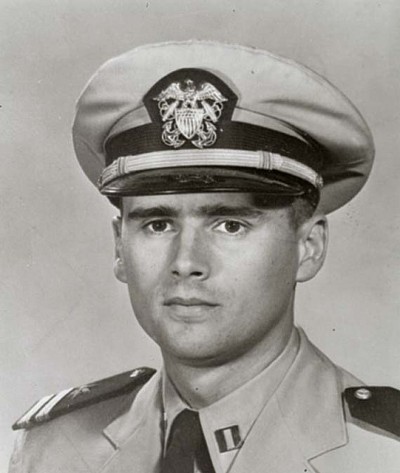Roger Chaffee (Roger Bruce Chaffee)

Roger Bruce Chaffee was born on February 15, 1935, in Grand Rapids, Michigan, where he became an Eagle Scout and graduated from Central High School in 1953. Turning down a possible appointment to the United States Naval Academy at Annapolis, Maryland, Chaffee accepted a Naval ROTC scholarship and in September 1953 enrolled at the Illinois Institute of Technology. After transferring to Purdue University in the fall of 1954, Chaffee earned a Bachelor of Science degree in Aeronautical Engineering in 1957. While there, he was a member of the Phi Kappa Sigma social fraternity, and the Tau Beta Pi and Sigma Gamma Tau engineering honor societies. While at Purdue, Chaffee took flight training as part of the Naval ROTC program in order to prepare him for a career as a Naval Aviator, soloing on 29 March 1957, and obtained his private pilot’s license on 24 May 1957. Chaffee married Martha Horn in Oklahoma City on August 24, 1957, whom he met while on a blind date in September 1955, and had two children, Sheryl Lyn (born November 17, 1958) and Stephen (born July 3, 1961).
Following graduation, Chaffee completed his Navy training on August 22, 1957 and was commissioned as an Ensign in the U.S. Navy. He would ultimately rise to the rank of Lieutenant Commander. After attending flight school at Naval Air Station Pensacola, Florida and Naval Air Station Kingsville, Texas, Chaffee was awarded his aviator wings in early 1959. Chaffee was given a variety of assignments and participated in numerous training duties over the next few years, spending the majority of his time in photo reconnaissance squadrons. He was stationed at Naval Air Station Jacksonville, Florida, serving as safety officer and quality control officer for Heavy Photographic Squadron 62 (VAP-62) flying the A3D-2P (later RA-3B) Skywarrior.
In the book Moon Shot: The Inside Story of America’s Race to the Moon, it is claimed that he flew the U-2 spy plane, a U.S. Air Force aircraft which took the pictures of Soviet missiles in Cuba which President Kennedy used on television on October 22, 1962. However, during this time Chaffee actually flew the U.S. Navy A3D-2P/RA-3B (a reconnaissance version of the carrier-based Douglas Skywarrior heavy attack/nuclear strike bomber). He was officially recognized for his service during the Cuban Missile Crisis with VAP-62, but his exact role is unclear and the Skywarrior was never employed in any overflights of Cuban territory during the crisis. In mid-1962, Chaffee was accepted in the initial pool of 1,800 applicants for the third group of NASA astronauts. In January 1963, he entered the Air Force Institute of Technology (AFIT) at Wright-Patterson Air Force Base in Dayton, Ohio to work on a Master of Science degree in Reliability Engineering. While at AFIT, Chafee would continue to participate in astronaut candidate testing as the pool of candidates dropped to 271 in mid-1963. During his Navy service he logged more than 2,300 hours flying time, including more than 2,000 hours in jet aircraft.
Chaffee was an avid hunter. After completing the astronaut application process, he went hunting to calm his nerves. It was while he was on that hunting trip that NASA called him to offer him an astronaut slot.[4] On October 18, 1963 he was officially announced as one of 14 chosen for Astronaut Group 3. He served as a capsule communicator (CAPCOM), along with Virgil “Gus” Grissom and Eugene Cernan, for the Gemini 4 mission, in which Edward H. White II made his space walk. Chaffee later served as one of the pallbearers for fellow astronaut Elliot See, who was killed in a plane crash while training for the Gemini 9 mission.
He never got a seat on a Gemini mission, but was assigned to work on flight control, communications, instrumentation, and attitude and translation control systems in the Apollo program. He was paired with Grissom to fly chase planes to photograph the launch of an unmanned Saturn 1B rocket. He received his first spaceflight assignment on an Apollo crew in January 1966, when he replaced Donn F. Eisele as Pilot for the first manned Apollo flight, AS-204, along with Command Pilot Grissom and Senior Pilot White. The crew announcement was made public on March 21, 1966. Eisele required surgery for a dislocated shoulder which he sustained aboard the KC135 weightlessness training aircraft, and was subsequently reassigned to the crew for the second Apollo flight, to be commanded by Mercury veteran Wally Schirra.
In June 1966, the men got permission to name their flight Apollo 1. On January 27, 1967, Grissom, White and Chaffee were participating in a “plugs-out” countdown demonstration test at Cape Kennedy in preparation for the planned February 21 launch, when a fire broke out in the cabin, killing all three men. Chaffee’s is believed by some to be the first cockpit voice to report the fire to ground controllers. During the seventeen seconds that the fire raged, fed by pure oxygen at slightly greater than atmospheric pressure, Chaffee stayed strapped to his right-hand seat, as it was his job to maintain communications in an emergency, while White in the center seat apparently tried in vain to open the hatch. At that point, the increasing pressure burst the inner cabin wall. Now fed by ambient air, the fire decreased in intensity and eventually put itself out, but produced large amounts of smoke, which killed the astronauts. Chaffee and Grissom are both buried in Section 3 of Arlington National Cemetery, while White is buried at West Point Cemetery.
Born
- February, 15, 1935
- USA
- Grand Rapids, Michigan
Died
- January, 27, 1967
- USA
- Cape Kennedy, Florida
Cause of Death
- smoke inhalation
Cemetery
- Arlington National Cemetery
- Arlington, Virginia
- USA



